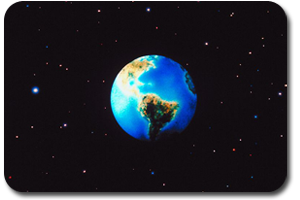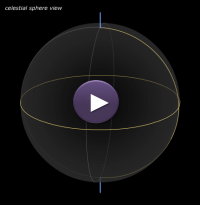
The Celestial Sphere
Rotating Sky Scientific Investigation

![]() Before you begin the scientific investigation below, make sure to download the Rotating Sky Scientific Investigation Report. As you complete this scientific investigation, fill in any needed information on the report template. If you need more information about each section of the report, please visit the Developmental Module.
Before you begin the scientific investigation below, make sure to download the Rotating Sky Scientific Investigation Report. As you complete this scientific investigation, fill in any needed information on the report template. If you need more information about each section of the report, please visit the Developmental Module.
This scientific investigation is available below or in a printable version.
Introduction
You might take for granted the stars you are able to see from your home each night. For instance, you may be able to clearly see a set of stars, like the Big Dipper, while someone in another location on Earth may not. As you have already learned, the rotation of the Earth makes it seem as if the sky rotates around the Earth, with the stars rising and setting. In this scientific investigation, you will use a simulator that will allow you to observe this situation.
Objectives
In this scientific investigation, you will:
- assign stars to a mock celestial sphere;
- observe the movement of stars; and
- investigate the visibility of stars to an observer.
Hypothesis
Using the Procedure and Data Collection section below, read through the procedural information for this scientific investigation. Based on your understanding of the procedure, develop your own hypotheses which describe your expected results. Specifically, how do you think stars will appear to move through the celestial sphere? How does a person's location impact the stars that they are able to see? Record these hypotheses in the Hypothesis section of your Rotating Sky Scientific Investigation Report.
Required Simulation
Rotating Sky Explorer
(click on image below to run simulation)
 |
Provided by:
Astronomy Department
University of Nebraska - Lincoln
Once you are on the site, you will see two images. The left image shows the celestial sphere with the Earth positioned in the middle. The right image shows the horizon diagram with an observer in a fixed location. By placing stars on the diagrams and placing your observer in a location of your choosing, you can determine with this simulator if someone standing at your observer’s location would be able to see a chosen star, and whether or not it rises and sets.
Procedure and Data Collection
- Access the Rotating Sky Explorer simulation from the University of Nebraska - Lincoln's Astronomy Education Department.
- Set your observer’s observation point (represented by the stick figure in the middle of the Horizon Diagram and by the dot on the Earth in the Celestial Sphere) by editing the fields in the Observer’s Location at the bottom of the screen, clicking a point on the map, or by adjusting the arrow keys.
- Add stars to the Celestial Sphere by clicking the various options under Star Controls at the bottom of the screen.
- Click on a given star on the celestial sphere. In the Horizon Diagram, type in the coordinates in the Azimuth field to position your selected star to Azimuth North.
- In the data section of your Rotating Sky Scientific Investigation Report, record that star’s coordinates measured by right ascension and declination on the Celestial Sphere and by azimuth and altitude on the Horizon Diagram.
- Click on Long Star Trails or Short Star Trails to see the trail left by the rising and setting stars during the animation.
- Under Appearance Settings, make sure that all options are checked so that they appear on the diagrams.
- Click Start Animation to see the rotation of the Earth and how the stars seem to rise and set. Record any observations about what the observer in the horizon diagram view would be able to see.
Data
Use the table provided on your Rotating Sky Scientific Investigation Report to record your data from this scientific investigation. The data table is also shown below:
| Right Ascension | Declination | Azimuth | Altitude |
Observation Notes:
Data Analysis
In the Data Analysis section of your Rotating Sky Scientific Investigation Report, provide responses to the following questions:
- Would your observer be able to see your chosen star from the vantage point you selected? Explain your answer.
- Does your star rise and set, or is it a circumpolar or never-rise star? Explain your answer.
Conclusion
Using the Conclusion section of your Rotating Sky Scientific Investigation Report, compose three to four sentences describing an overall conclusion based on your data. Were your hypotheses true or false, and how do you know? Use the data and notes that you collected from your investigation to form your conclusion. Make sure that you include information that you gained from data analysis to support your conclusion.
Experimental Sources of Error
On your Rotating Sky Scientific Investigation Report, provide responses to the following questions: Are there any sources of error? If so, what are they, and what could be done to minimize error?
![]() Once you have completed the Rotating Sky Scientific Investigation Report, please submit your work to the dropbox.
Once you have completed the Rotating Sky Scientific Investigation Report, please submit your work to the dropbox.



